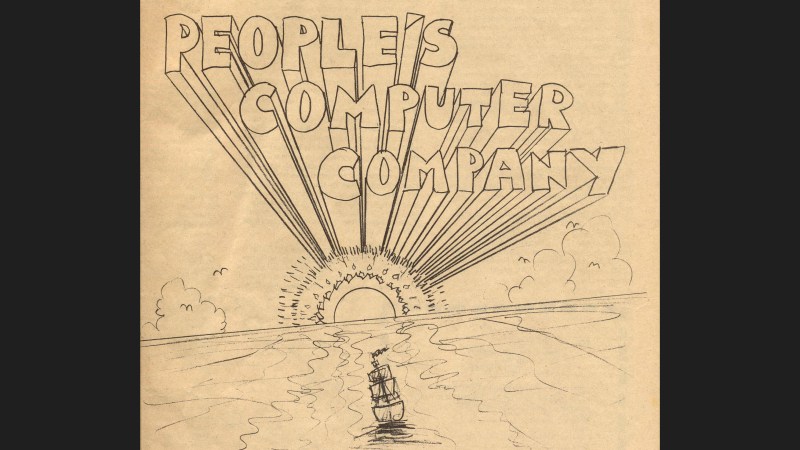If you are a certain age, you might recall the People’s Computing Company (PCC) from the 1970s. It was not really a company, but rather a folksy computer newsletter in the visual style of the times. In the first issue, published in October 1972, founders Dennis Allison, Bob Albrecht and George Firedrake explained their reasons for starting the newsletter:
Computers are mostly used against people instead of for people, used to control people instead of to free them; time to change all that — we need a … People’s Computer Company
The Computer History Museum (CHM) in Mountain View CA has a print collection of these issues donated by [Jim Warren], spanning its ten-year publication run (it changed name to Recreational Computing in 1979). Despite the museum being closed to the public these days over Covid concerns, CHM supporter [Bob Zeidman] has scanned all the issues and they are available at the CHM collections archive.
It’s really fun to browse through these old issues, and see the kinds of topics which were of interest back then. Many would still be of interest today, and many others have become obsolete by advances in technology (but are still fun to read if you have an interest in retro-computing). For example, in the first issue you can read about why you might use different lenses on your Bell & Howell film projector, a comparison of DEC and HP computers as used in educational settings, and how to save money on your teleprinter maintenance contracts and consumables like TTY paper, ribbons, and punched paper tape. If you have some time to kill, check out these archives and take yourself back to a time when desktop publishing meant literally typing and drawing freehand with metal styli on special stencils which were mounted on drums in your mimeograph machine one page at a time.
The PCC was an early supporter of copyright-free software, teaching computer programming, using computer games as a learning tool, and encouraging computer literacy for everyone. They did this not only via the newsletter, but educational books, an organization called ComputerTown USA! for teaching kids, and spin-off periodicals like DragonSmoke and Dr. Dobb’s Journal of Computer Calisthenics & Orthodontia (edited by [Jim Warren] mentioned above) which went on to become the popular computer magazine Dr. Dobb’s Journal which stayed in publication until 2014. We wrote a piece a few years ago about a software-defined radio project from the PCC back in 1975. Do you have any favorite old journal archives that you like to peruse from time to time?
















Running light without overbyte! I miss Dr. Dobbs.
and CUJ too !
The Rockford files tv show did an episode showing the thoughts of computers tracking people. It was late 70s but along the lines.
https://archive.org/details/PDTV0144#
Also Captain Crunch was featured in another episode “you doing some long distance dialing?”
I have the first 25 years of the HPJournal in original printed format, back when they were trying to publish original research rather than make thinly veiled advertisements for their products, and it is kinda cool reading but it too is a lot of work on stuff that’s seriously obsolete. They spent a ton of time characterizing germanium transistors.
Wikipedia isn’t a great source, people who came later have garbled it.
PCC was a storefront, I can’t remember if it came first or at the same time as the newsletter. It got funding from the Portola Institute, original home of the Whole Earth Catalog (and the Big Rock Candy Mountain which was about learning). People could drop by the storefront and get access to a computer, so unless they had a minicomputer, it was via timesharing. Hence the focus on BASIC.
It’s an odd time because it probably influenced the Whole Earth Catalog and descendants to cover computers, but Stewart Brand had been at the 1968 Big Demo of Doug Englebart’s, and around the start of PCC, Lee Felsenstein was involved in Community Memory, a computer bulletin board with access via public terminals (2 or 3) in public places. So there was crossover. Whole Earth’s first computer editor was Marc LeBrun, who was connected to PCC.
I’m not sure PCC was really an early proponent of copyright-free software. I suspect it was less deliberate, , more the way hobby electronic magazines of the time would publish articles. It only really became a concept as for-profit software became a thing, especially with home computers.
PCC was big on BASIC, not a surprise before microcomputers. Once the Altair came along, PCC wanted BASIC for it, so a concept article was published, outlining a two layer interpreter (the inner layer simple, but machine code, the outer layer couod remain constant across CPUs) either in PCC newsletter, or Dr. Dobbs. Dr. Dobbs was to be a single shot, toget tye concept going, but of course did runfor decades.
PCC also published later the Computer Music Journal.
I thought Dragonsmoke was more a Bob Albrecht project, coming out in the eighties, I remember when it was announced in Rainbow, the Color Computer magazine. Yrs, overlap of course ndividuals, but not a PCC project, even if it continued the concept.
PCC. Best consumed with acid.
As opposed to the Speakeasy which was consumed with fire.
I guess I must be “of a certain age” as was there for PCC and the birth of Personal Computing. Bob Albrecht has retired although I am told he continues to write teaching material about BASIC. I am still active in the computing field but more as an advisor than a researcher/developer. It’s always a surprise to see how far we have come.
I treasure my 6 copies of PCC.
How they found me in late 1976 in a small town in Colorado is a complete mystery to me, but it was the same year I got hand-on with a computer.
Ah. Memories from my early teen age years. Groovy.
Same Jim Warren who ran the Computer Faire in SF?